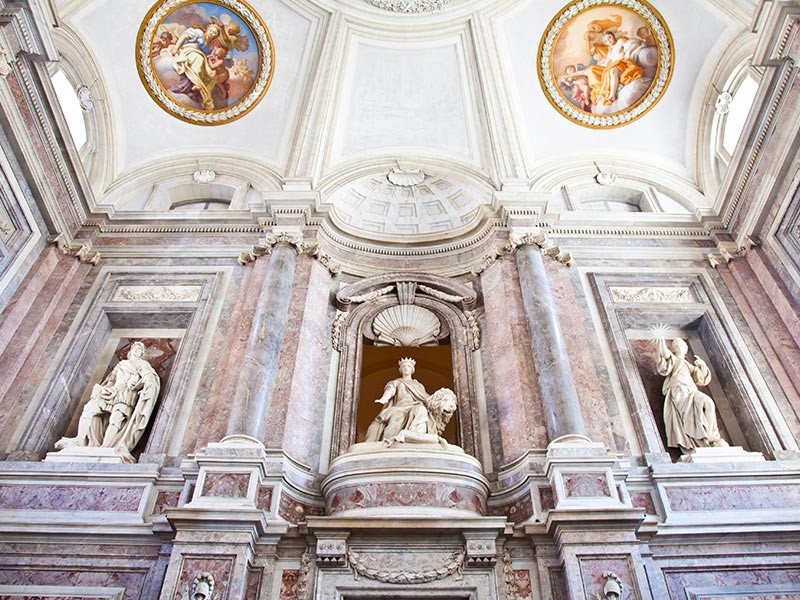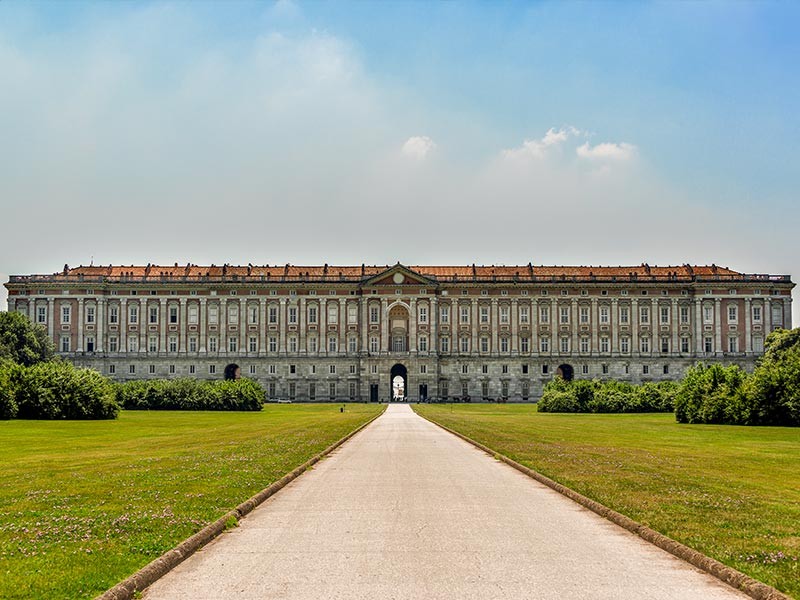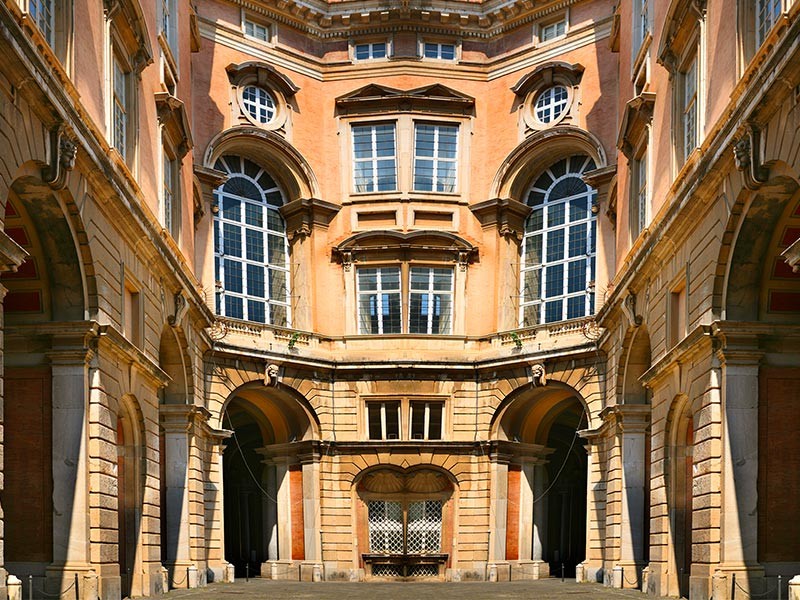Admire the Caserta Palace complex, a building which, beyond housing the Royal family, accommodates a university, the ministries, a public library, the magistracy, a large theater, a seminary, and a cathedral church;
Info & Booking
Cumulative ticket: Historic apartments, exhibition Terrae Motus, Park and English Garden
Closed on Tuesday, January 1st and December 25th
Opening hours:
Apartments: 8:30 - 19:00; last entrance: 18:30
Exhibition: 9:00 - 18:00 guided visit by museum's assistants each hour
Park and Garden:
- January, February, November and December: 8:30 - 14:30
- March: 8:30 - 16:00
- April 8:30 - 17:00
- May and September: 8:30 - 17:30
- June, July and August: 8:30 - 18:00
- October: 8:30 - 16:30
The English garden closes one hour before the last entrance to the Park
Reservations must be made with a minimum of 1 day notice.
Save time in ordering! Add into your basket all the museum tickets you want, then fill the form and send the request.
Before making your reservation, please, read the Ordering Informations
IMPORTANT NOTICE: After successfully completing a reservation, you will receive two e- mails: the copy of your order (immediately after submitting your order) and the confirmation mail (one working day after). In order to receive them, please make sure you insert your e-mail address correctly and check that your anti-spam filter or anti virus are not blocking mails from our address [email protected]. Special attention for AOL mailbox users.
PLEASE NOTICE: Confirmed time is not always the same time you requested; museum automatically confirms the closest available time on the same date if requested time is sold out.
WHISPER SERVICE:
According to instructions by the Ministero per i Beni e le Attività Culturali, visitors in group over 12 people are due to get whispers for their visit before entering the museum. Whispers can be gotten next to the cashier or at the cashier itself. Payment must be made to the cashier (Euro 1.80 for each member of the group, despite age, citizenship or profession; Euro 1.20 for each member of school groups; whispers for tourist guides from Campania are free).
Cancellation Policy:
For cancellations once a confirmation code has been assigned to the reservation, up to 2 days before the date of the visit, we can refund cost of unused tickets minus service fee (reservation fee and online booking fee). For further cancellations and no shows, no refund is possible.
Before You Book
PLEASE NOTE: Immediately after submitting an order, you will receive two email. The first email contains your order summary (this one you receive immediately after placing your order), the second email confirms your successful payment (one business day after placing the order). In order to receive these two emails, please make sure that you enter your email address correctly and check that antispam or antivirus filters do not block emails from our [email protected] address. Users of AOL, Comcast and Sbcglobal.net need to pay special attention to this, please. Vouchers will also be available, one business day after the request, at your dashboard.
IMPORTANT NOTE: The time you select on the order form is your preferred time. The closest available time, which can be anytime during opening hours on the selected date, will be automatically confirmed if your preferred time is no longer available.
Intro
Admire the lavish Caserta Palace complex, Versailles of the Campania region. It not only housed the Bourbon kings of Naples, but also accommodated a university, the ministries, a public library, the magistracy, a large theater, a seminary, and a cathedral church. Breathtaking architecture, splendid vistas, beautiful parks and gardens – visit the UNESCO World Heritage Site near Naples!
Caserta Palace
In 18th century Europe, the ruling classes constituted something of a “single nation” that spanned national boundaries. From Paris to Saint Petersburg, from Berlin to Naples, French was the universal language of the aristocracy and the intellectual classes. The wide acceptance of the Enlightenment philosophy as well as the cultivation of the arts and the widespread presence of the Masonic orders throughout the European continent were signs of this “single nation.”. Many palaces built during this era - symbols of royal patronage and splendor - survived ensuing revolutions, wars, and neglect, thus leaving some of the most tangible traces of the period.
Following the death of the Emperor Charles VI, a new war broke out and Charles VII of Naples found himself in need of constructing a new capital at a distance from the sea, but not too distant from Naples. The place best suited was at the foot of the Tifatini Mountains, a property of the Counts of Caserta, staunch adversaries of the Bourbons.
Architect Luigi Vanvitelli's model for the Caserta Palace was inspired by the unparalleled Versailles, where Charles the VII had spent much time as guest of the French court. Beyond housing for the royal family, Vanvitelli's plans for the Caserta Palace included a university, the ministries, a public library, the magistracy, a large theater, a seminary, and a cathedral church. After having requested the consent of Pope Benedict XIV, Charles conferred the project upon Vanvitelli, architect at Saint Peter's Basilica in Rome.
Vanvitelli presented his plans for the Caserta Palace in sixteen engravings. Beyond the many aspects of the palace, they included plans for the new city which was to rise beside it. The backbone of the the project was to be the Gran Viale between Naples and the great waterfall that gushes from the hillside of Briano. The Viale, connecting the new capital with the far away metropolis, was to be skirted by streams, derived from the Caroline Aqueduct - but it was never realized.
The San Leucio Hill is situated to the north east of the Caserta area. The Belvedere Palace of San Leucio, with views extending to the sea, was already described in the survey of the assets of the princess Anna Acquaviva in 1635. A genuine castle, it boasts frescoes, marbles, arcades, and laurel and citrus adorned loggias. The gardens and woods, the countryside and neighboring vineyards include areas reserved for hunting.
King Charles VII in fact established a wild boar hunting reserve here, but it was his successor Ferdinand IV who decided the destiny of these places where he had spent his childhood. He added more land and ordered the construction of a small building that would offer repose to the hunters: the Vaccheria. A silk factory was later established in this building, with craftsmen brought in especially from Piemonte in the north of Italy.
The death of heir to the throne Charles Titus here spurred the royal family to abandon it and transfer the activity and the craftsmen to the Belvedere.
The “Collecini Project” - named after the architect who had already collaborated with Vanvitelli in the construction of the Royal Palace - anticipated the construction of a true industrial city – “Ferdinandopoli.” It was to be the home of factories, intensive cultivation of the arable areas, and include living quarters for the workers whose life would evolve around the great silk piazza at the center. But the French occupation put the ambitious project into crisis and San Leucio did not become this modern industrial city. Of the original plans, only a few aspects were completed - the living quarters (one of the first examples of terraced housing), the house of San Silvestro, the Vaccheria, and the road network system.
The Carditello site dates back to the decision of King Charles to establish a stud farm in the feud belonging to the Count of Acerra. It was only during the reign of his son Ferdinand that the architect Collecini was charged with the task of designing the building in 1787. Carditello was to serve the double function of royal hunting refuge, and farm. In Ferdinand's mind, Carditello served to demonstrate his support for the old agricultural methods, while San Leucio was supposed to represent the new model of industrial development derived from Enlightenment ideas, which would work for the benefit of the people.
Cancellation Policy
Once a confirmation code has been assigned to your reservation, we can refund the cost of unused tickets, also for no-shows, minus a service fee (reservation fee and online booking fee).



